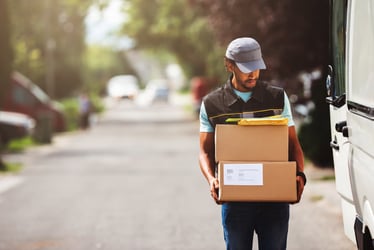Related Posts



You are about to leave Risk Strategies website and view the content of an external website.
You are leaving risk-strategies.com
By accessing this link, you will be leaving Risk Strategies website and entering a website hosted by another party. Please be advised that you will no longer be subject to, or under the protection of, the privacy and security policies of Risk Strategies website. We encourage you to read and evaluate the privacy and security policies of the site you are entering, which may be different than those of Risk Strategies.

With the rise of the millennial e-commerce shopper, consumer interest in same day and home delivery is already high—and quickly rising. In a recent report on same day delivery, BI Intelligence researchers found that “Six in 10 US shoppers said they would use same day delivery if they didn't have time to go to the store, and one in four shoppers said they would consider abandoning an online shopping cart if same day delivery was not an option.” This shift in buyer behavior is unlikely to reverse its current trend. And as the traditional supply chain, logistics and delivery industries evolve to meet these demands, the changing landscape presents new, unique challenges.
Now, same day and home / last mile delivery operations must find new, innovative solutions to help keep customers happy and inventory organized, safe and (most importantly) on time. Oh, and then there is the issue of insuring the business and its employees against costly risks and associated liabilities.
Below, we explore how the rise in online shopping is impacting the industry, and some of the key challenges facing today’s same day and home / last mile delivery service providers.
With the surge in online shopping, new players are entering the market, which drives up competition and drives down profits. It has become increasingly important for delivery providers to innovate to remain competitive and profitable. This is especially true for home delivery providers since an estimated 28 percent of total delivery costs are associated with last mile delivery.
With tech giants like Amazon and Google experimenting with their own fleets (and drones) to adopt a direct-to-consumer business model, this will likely be a game changer for the general market of couriers and independent contractors (ICs). Increased competition from major players with enormous resources (i.e. ownership of the entire supply chain, logistics and delivery process) will push couriers and ICs to improve and adjust across the board.
From integration of technology to efficiencies, the demand for affordable, transparent, quick and reliable delivery services will heighten. And with drivers striving to delivery items to customer doors at a faster and more accurate rate, you open the possibility to increased errors and damages. As a result, losses, and liabilities skyrocket, shifting focus to the coverage that protect these operations.
If you doubt the likelihood of this impending threat, we’re already starting to see a glimpse of what the future could look like as ride share companies like Uber make a play for home delivery through solutions like UberEats
As we’ve noted before, the rise in e-commerce and demand for accompanying delivery services is pushing couriers, carriers, and independent contractors (ICs), as well as their insurers, to solve for the changing complexity in same day and last mile delivery insurance needs.
From additions like cyber and professional liability insurance to enhanced commercial auto coverage, the industry is under pressure to offset and transfer liabilities where possible. Not to mention the increased need to better protect businesses and their employees against new exposures in the evolving market.
From top to bottom, the industry is feeling the changes of an evolving market—one where logistics, services, pricing, and insurance will continue to see changes in the coming years.
As home delivery business insurance needs are evolving, so are the appetites of insurance providers.
The insurance market for home and last mile delivery is shrinking, as a number of flagship insurers have left the market, reducing carrier and IC options for industry-specific insurance programs and coverage.
“Why are insurers removing their programs from the market? Because underpricing in the commercial auto sector over the past few years hasn’t kept pace with the loss performance,” said Bryan Paulozzi, VP at Risk Strategies. “Furthermore, auto related claims have been on the rise due to more distracted drivers on the road, plus the ability to tracks ones distraction prior to a crash if they are texting, tweeting, etc. — it all adds up to “nuclear verdicts” that are hitting the commercial auto insurance carriers hard.”
More so than ever before, it is essential that same day and home delivery services find an insurance partner they trust and can rely on for affordable and adequate coverage.
Connect with the Risk Strategies transportation team at B3@risk-strategies.com
Or Get a Quote Today Here!
The contents of this article are for general informational purposes only and Risk Strategies Company makes no representation or warranty of any kind, express or implied, regarding the accuracy or completeness of any information contained herein. Any recommendations contained herein are intended to provide insight based on currently available information for consideration and should be vetted against applicable legal and business needs before application to a specific client.


